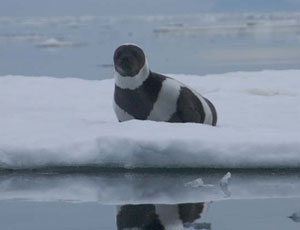
(Photo: M. Cameron / NOAA)
When it comes to the consequences of global warming, polar bears have icon status. They're big and beautiful, they can walk on their hind legs, and when they're swimming for distant ice floes, you can't help but feel a tug of remorse about that last time you raced your Hummer down the highway. That, and they have already been designated for protection by the Endangered Species Act, largely because of global warming.
But with the Arctic melting fast due to global warming (which is reversing the trajectory toward another ice age, according to one study), the polar bear is not the only species being affected. As the globe's ice cap recedes and breaks up, several other species are suffering too.
But first, how fast is the Arctic melting? When the summer melt began, scientists worried that so much Arctic sea ice would melt that we would see another record, like the one set in 2007 and nearly matched in 2008. A swirl of Arctic winds seems to have prevented that worst-case scenario, but the Arctic is still headed for its third-lowest ice extent ever recorded, behind 2007 and 2008. While the sea ice extent in August was 14% greater than the record-low set in 2007, it was 18% below average.
That leaves species dependent on sea ice swimming farther for their meals, dens or other life necessities. Two examples:

(Photo: NOAA)
The Pacific Walrus
Pacific walruses live in the Bering and Chukchi Seas, where they use floating ice for birthing and nursing calves, resting, protection from predators, and floating to new feeding areas, according to the U.S. Fish and Wildlife Service.
The U.S. Fish and Wildlife Service on Tuesday announced that the Pacific walrus is likely threatened by climate change. That's the first step toward granting a petition filed by the Center for Biological Diversity, seeking to list the species as threatened or endangered, and therefore protected by the Endangered Species Act.
The Ribbon Seal
Like the walrus and the polar bear, the ribbon seal depends on sea ice for its lifestyle in the Bering, Chukchi, and Okhotsk seas off Alaska and Russia. In addition to global warming, oil and gas development is encroaching on its habitat, activists say. (The Obama administration recently exempted Shell Offshore from restrictions in the Marine Mammal Protection Act, allowing the company to disturb seals as it explores for oil in the Chukchi Sea.)
Unlike the walrus and the polar bear, the ribbon seal is unlikely to get listed as a threatened or endangered species. Late in the Bush administration, the USFWS rejected a petition by the Center for Biological Diversity. That decision could be reversed, however, as both the center and Greenpeace, have sued in an attempt to protect the species.
The process of listing Arctic species on the Endangered Species List is closely watched for several reasons, primarily because it could trigger consideration of greenhouse gas emissions in all federal decision-making (though that consequence was specifically rejected by the Bush administration when it listed the polar bear as threatened). Also, protecting these species might well require the preservation of vast stretches of the Arctic that oil and gas companies want to explore and develop.
The Arctic, in a larger sense, is being watched because it's a bellwether for the rest of the globe. As a recent WWF report made plain, independent science since the last United Nations assessment shows that global warming is affecting the Arctic faster than predicted, and that consequences for the rest of the globe -- changed weather patterns, higher sea levels, etc. -- are likely to be more extreme.
No comments:
Post a Comment